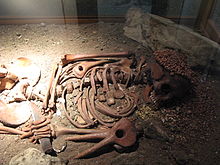Arene Candide
Arene Candide is an archaeological site in the commune of Finale Ligure ( Savona province ) in the Italian region of Liguria . It is a cavern that was created by the strong post-glacial winds that carried large amounts of sand in front of the Caprazzoppa (plateau). Industrial use reduced the amount of quartz sand considerably, so that the former dune is practically eroded today.
Digs
After the bone finds mentioned by Arturo Issel in 1864, the later excavation site went down in archaeological literature as Caverna delle Arene Candide . Larger excavations took place under the direction of Luigi Bernabò Brea and Luigi Cardini in the years 1941 to 1942 and 1948 to 1950. Traces of Paleolithic to Byzantine relics from the period between 26,000 BC were found. BC and AD 700. Only about a fifth of the cave has been excavated so far, so it is believed that the lowest layers contain artifacts from the time of the Neanderthals .
Burials from the Paleolithic
19 paleolithic burials, some of them with rich grave goods, made the dune one of the most productive sites in Europe. For example, the man known as the Little Prince , who was buried around 23,000 years ago, was given a fur cloak made of 400 vertically arranged squirrel skins. 423 squirrel tail bones were assigned to the cloak.
The prince lay stretched out in a layer of ocher . Dark stones formed the edge of the grave. The young man's head was turned to the left and surrounded by hundreds of pierced snail shells and deer grandles (canine teeth). They are probably from a hat or a mask. Mammoth ivory pendants , pierced Cypraea snail shells, four perforated rods made of deer antler and the said squirrel bones surrounded him. In his right hand he held a stone dagger made of exotic flint. The left half of the lower jaw is missing, there is a large amount of ocher. The injury had started to heal, possibly the ocher should help. The radiocarbon dating yielded a 14C age of 23,440 ± 190 BP years.
literature
- Luigi Cardini: Dipinti schernatici antropomorfi della Grotta Rornanelli e su ciottolo dei livelli mesolitici della Caverna delle Arene Candide e della Grotta della Madonna a Praia a Mare . Atti della XIV ° Riunione Scientifica dell'Istituto Italiano di Preistoria e Protostoria in Puglia, Florence 1972, pp. 225-235.
- Giorgio Paoli, Raffaello Parenti, Sergio Sergi: Il giovane paleolitico della Caverna delle Arene Candide , in: Memorie dell'Istituto di Paleologia Umana 2 (1974) 13-38.
- Giorgio Paoli, Raffaello Parenti, Sergio Sergi: Gli scheletri mesolitici della Caverna delle Arene Candide (Ligura) , in: Memorie dell'Istituto di Paleologia Umana 3 (1980) 33-154.
- Luigi Cardini: La Necropoli Mesolitica delle Arene Candide , in: Studi di Paletnologia, Paleontropologia, Paleontologia e Geologia del Quaternario, Memorie dell'Istituto Italiano di Paleontologia Umana, 3 (1980).
- Amilcare Bietti (Ed.): The Upper Pleistocene Deposit of the Arene Candide Cave (Savona, Italy): New Studies on the 1940-42 Excavations , Quaternaria Nova, IV (1994).
- Roberto Maggi (Ed.): Arene Candide. Functional and Environmental Assessment of the Holocene Sequence , Il calamo, 1997.
- Santo Tiné, Daniele Arobba (ed.): Neolitico nella Caverna delle Arene Candide (scavi 1972-1977) , Istituto Internazionale di Studi Liguri , Bordighera 1999.
Web links
- Museo Archeologico del Finale
- Finale Ligure (Sv). Scavo archeologico nella caverna delle Arene Candide , Archeo Rivista
Remarks
- ^ Luigi Bernabò Brea: Gli scavi nella caverna delle Arene Candide , Bordighera 1946.
- ↑ Luigi Cardini: Nuovi documenti sull'antichità dell'Uomo in Italia: reperto umano del Paleolotico superiore nella Caverna delle Arene Candide , in: Razzi e Civiltà III (1942) 5-25 and Ders .: Gli strati paleolitici e mesolitici della Caverna delle Arene Candide , in: Rivista di Studi Liguri 12 (1946) 29-37.
- ↑ Art. Mantel , in: Reallexikon der Germanischen Altertumskunde , Volume 19, here: p. 239.
- ↑ Catherine Panter-Brick: Hunter-Gatherers. An Interdisciplinary Perspective , Cambridge University Press 2001, p. 52.
- ^ Paul Pettitt : The Palaeolithic Origins of Human Burial , Routledge 2011, p. 182.
Coordinates: 44 ° 9 ′ 42.4 " N , 8 ° 19 ′ 34.9" E


